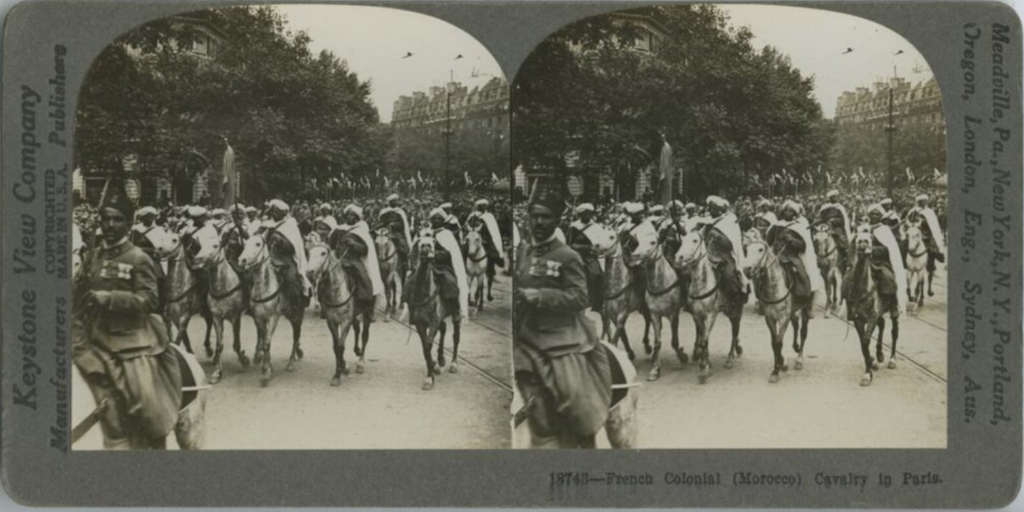From Occupation to Independence: Morocco's Colonial Journey

By: Rania Basria / Arab America Contributing Writer
Moroccan colonialism’s history is rich and diverse, spanning several centuries and involving numerous foreign powers. Morocco, with its strategic location at the crossroads of Europe and Africa, has long been desired by empires wanting to expand their reach. This article analyzes Moroccan colonialism from the 15th-century Portuguese incursions to the 20th-century French and Spanish protectorates, highlighting resistance, perseverance, and final emancipation.
The Portuguese were among the first Europeans to establish their presence in Morocco. In the early 15th century, they took numerous major coastal cities, notably Ceuta in 1415, signaling the start of Portuguese imperial expansion in North Africa. The Portuguese were motivated by a combination of commercial goals, including control over lucrative trans-Saharan trade routes, as well as theological motives, including the desire to promote Christianity.
Despite early victories, Portuguese dominance over Morocco was short-lived. The Moroccan resistance was vigorous, and by the mid-16th century, most Portuguese fortresses had been retaken by native forces. The Battle of Alcácer Quibir in 1578 was a watershed moment, with the Portuguese suffering a crushing loss. This conflict not only terminated Portugal’s ambitions in Morocco, but it also greatly reduced their regional influence.
The collapse of Portuguese dominance coincided with the development of the Alaouite dynasty in the 17th century, which would eventually play a critical role in uniting and strengthening Morocco. The Alaouites, who claimed ancestry from the Prophet Muhammad, tried to establish their power over Morocco’s scattered lands. Morocco had considerable power consolidation and territory expansion under kings such as Moulay Ismail, who ruled from 1672 until 1727.
Despite growing European interest in the region, Morocco was able to preserve some independence and sovereignty throughout this time. The Alaouite sultans expertly managed the complicated political situation, engaging in diplomacy and trade with European countries while maintaining control over domestic affairs.
By the late nineteenth and early twentieth century, European nations had increased their battle for control of Africa, with Morocco being a focal focus of their goals. France and Spain, in particular, aimed to expand their influence in the region. The Treaty of Algeciras, signed in 1906, attempted to reconcile European countries’ opposing interests in Morocco, but it eventually established the framework for the formation of French and Spanish protectorates.
The Treaty of Fez, signed in 1912, confirmed Morocco’s partition into French and Spanish rule zones. France grabbed the majority, including significant towns like Casablanca, Rabat, and Marrakech, while Spain controlled minor parts in the north and south. The foundation of protectorates signaled the start of a new era of colonial rule in Morocco.
The Treaty of Fez, signed in 1912, confirmed Morocco’s partition into French and Spanish rule zones. France grabbed the majority, including significant towns like Casablanca, Rabat, and Marrakech, while Spain controlled minor parts in the north and south. The foundation of protectorates signaled the start of a new era of colonial rule in Morocco.
The French and Spanish colonial governments made considerable changes in Morocco. They tried to modernize infrastructure by building roads, trains, and ports to promote resource extraction and export. Agricultural techniques were modified to promote colonial interests, frequently at the expense of local communities.
However, colonial control caused massive opposition among Moroccans. Nationalist groups emerged, advocating for independence and an end to foreign dominance. The Moroccan nationalist movement gained traction in the 1930s and 1940s, with personalities such as Allal al-Fassi and the Istiqlal Party leading the way.
The struggle for independence became increasingly urgent after World War II when a global wave of decolonization swept through Africa and Asia. Morocco has seen an upsurge in protests, strikes, and civil disobedience. The French responded ruthlessly, clamping down on nationalist activities and imprisoning leaders.
The turning point occurred in the early 1950s when the colonial powers were unable to ignore the growing demand for independence. In 1953, the French banished Sultan Mohammed V, which further increased nationalist determination. Mass demonstrations and worldwide pressure grew, prompting the French to change their attitude.
Morocco’s post-independence period was characterized by efforts to unite the country and confront the legacy of colonial rule. Mohammed V, and subsequently his son Hassan II, tried to consolidate authority and undertake reforms to modernize the country. However, the transition was not without difficulties, including political unrest, regional inequities, and socioeconomic hardships.
Morocco’s colonial past had a long-term influence on its national identity and growth trajectory. Morocco’s war for independence instilled a strong feeling of nationalism and perseverance among its people. The legacy of colonialism may still be seen in many parts of Moroccan culture, ranging from legal and educational institutions shaped by French and Spanish models to current territorial conflicts.
The history of Moroccan colonization demonstrates the Moroccan people’s perseverance and resolve. Despite centuries of foreign rule, Morocco was able to retain its cultural identity and eventually attain independence. The colonial past, with its complexity and inconsistencies, continues to impact Morocco’s present and future as it navigates the difficulties of a fast-changing global landscape.
Check out our Blog here!









